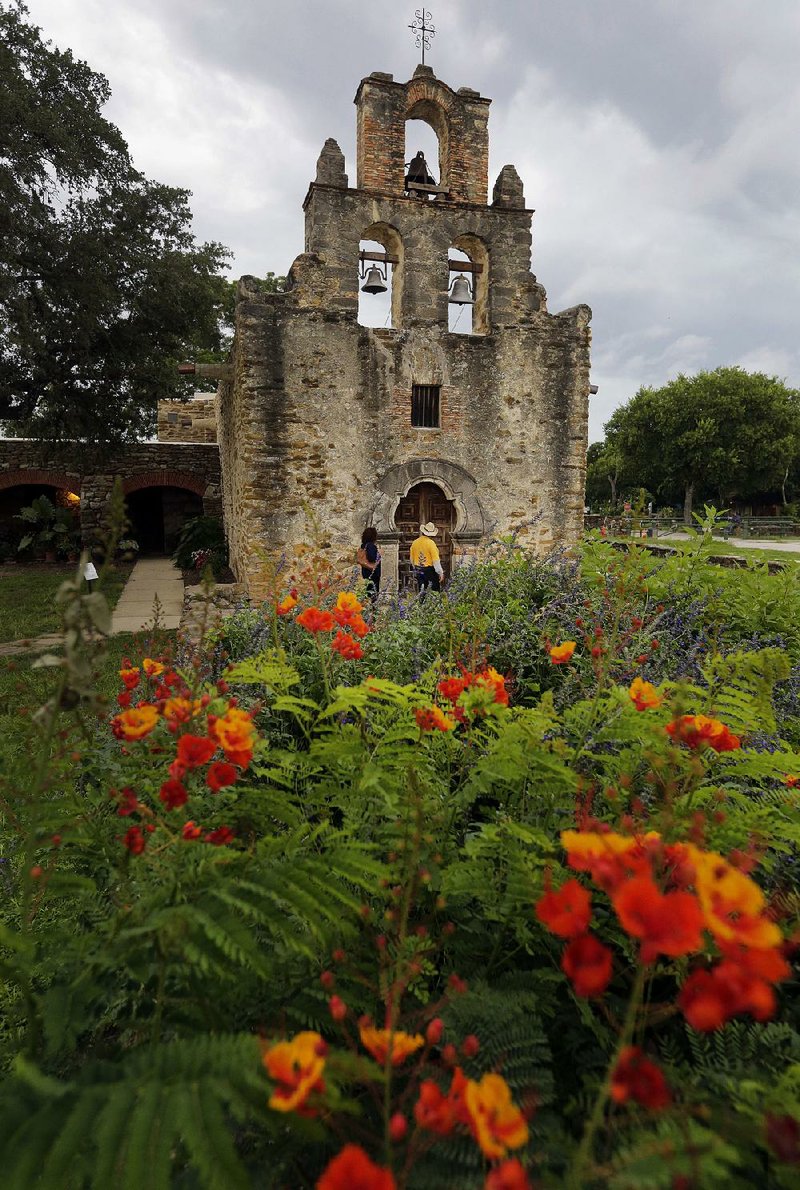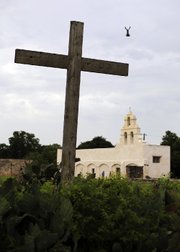BONN, Germany -- The United States has succeeded in its bid to get the United Nations Educational, Scientific and Cultural Organization's World Heritage Committee to "Remember the Alamo."
The Alamo is one of five Spanish Roman Catholic sites, known as the San Antonio Missions, to receive the coveted label from the cultural body. The designation, given earlier this month, is likely to increase tourism.
More than 20 other sites from around the globe were also approved, including the Gunkanjima industrial site off Japan that South Korea had long objected to.
Susan Snow, an archaeologist for San Antonio Missions National Historical Park, said the site in Texas represents "the very essence of the great melting pot of the United States."
"These missions are a living example of the interchange of cultures bringing together the indigenous, Spanish, Mexican and other influences that form south Texas today," Snow said.
The missions were built in the 18th century in and around what is now the city of San Antonio to convert indigenous people to Catholicism and make them Spanish subjects.
The best known of the missions, The Alamo, was the site of the famous 1836 battle when an outnumbered band of Texas settlers staged a courageous stand before Gen. Antonio Lopez de Santa Anna and his Mexican forces seized the mission. During the Battle of San Jacinto weeks later, then-victorious Texas soldiers shouted, "Remember the Alamo!"
The missions and the land around them became a national historical park in 1983, and all except the Alamo are still used as Catholic parishes.
Officials hope the designation of the largest collection of Spanish colonial architecture in the United States will boost tourism, already responsible for one in eight jobs in San Antonio.
The missions were the only sites in the United States proposed for world heritage status this year. Other American icons already on the list include the Statue of Liberty and the Grand Canyon.
Japan received world heritage status for a collection of almost two dozen sites that illustrate the country's industrial revolution during the 19th century.
The unanimous vote in favor of Japan's bid was approved only after Tokyo and Seoul resolved a spat over whether to acknowledge the sites' history of wartime forced labor, particularly that of Gunkanjima, or Battleship Island.
The fortress island near Nagasaki was key to Japan's rapid development during the 1868-1912 era of the Meiji Emperor, who sought to catch up with Western colonial powers.
Until recently, Seoul had objected to the listing unless the role of Korean prisoners forced to work there during World War II was formally recognized.
"Japan is prepared to take measures that allow an understanding that there were a large number of Koreans and others who were brought against their will and forced to work under harsh conditions in the 1940s at some of the sites," the Japanese delegation said after the decision.
Other sites that have been granted world heritage status include:
• The Burgundy vineyards south of Dijon, France, which have been shaped by centuries of wine making. Along with surrounding villages and the historic center of Dijon, the site represents an industry in existence since at least the 12th century.
• Champagne, the sparkling wine distinctive of the eponymous French region, represented in the vineyards, the cellars where the bottled wine ferments a second time, and the storied sales houses.
• The Diyarbakir Fortress and Hevsel Gardens of Turkey, which go back to ancient Greek and Roman times.
• The Par Force Hunting Landscape northeast of Copenhagen, a sculpted woodland where Danish kings hunted with hounds until the 18th century.
• A Lutheran church settlement known as Christiansfeld, also in Denmark. Founded in 1773 in the region of South Jutland, the town was built around a central church square to represent the democratic ideal of this Protestant denomination.
• Tusi sites in southwest China, named after the tribal chiefs who ruled there from the 13th to the early 20th century.
• The archaeological mounds and Ardeshir's palace along the Shavur River in Iran. Known as Susa, the site was continuously settled from the fifth century B.C. until the 13th century.
• The Maymand valley region of central Iran inhabited by semi-nomadic people who move between mountain pastures and caves depending on the season.
• Singapore's Botanical Gardens, which were created in 1859 and have since become a world-class conservation and research site, as well as a major tourist attraction for the city state.
• The Baekje region of South Korea comprising archaeological sites dating from the late fifth to late seventh century.
• Mongolia's sacred Great Burkhan Khaldun Mountain where Central Asian steppe meets the Siberian taiga. Tradition holds that it is the site of Genghis Khan's birth and burial.
• Sicilian churches and palaces dating to the island's 12th-century Norman rule, which incorporated Arab and Byzantine culture.
• Christian pilgrimage sites in modern Jordan where Jesus is said to have been baptized, along with Roman and Byzantine remains in the area.
• Prehistoric rock art showing human and animal figures in Saudi Arabia's Hail Region.
• Hamburg's Speicherstadt district, a vast complex of red-brick warehouses built between 1883 and 1927 in Germany's biggest port.
• The Rjukan-Notodden industrial site in Norway, built in the early 20th century to produce fertilizer to meet the booming demand from agriculture.
• The Necropolis of Beth She'arim, a series of catacombs built from the second century B.C. onward as a Jewish burial place. Located southeast of Haifa, Israel, the site features inscriptions in Greek, Aramaic and Hebrew.
• Scotland's Forth Bridge, completed in 1890 to carry trains over the Forth River and still in use today.
• The ancient Greek and Roman settlements at Ephesus in Turkey, once the site of the Temple of Artemis -- one of the Seven Wonders of the World. A Christian chapel from the fifth century has also become a major pilgrimage site.
• The Aqueduct of Padre Tembleque Hydraulic System on the Central Mexican Plateau. Dating to the 16th century, the canal system was conceived by a Franciscan friar and combines Roman hydraulics and traditional Mesoamerican construction techniques.
• Uruguay's Fray Bentos industrial site set up in the 19th century to process and export meat to Europe.
• The Blue and John Crow Mountains, Jamaica's first world heritage site. Located on the southeast of the island, they became a refuge for indigenous people and escaped African slaves during colonial times and are considered a biodiversity hot spot.
For more information on all world heritage sites, visit whc.unesco.org/en/list.
Travel on 07/26/2015



